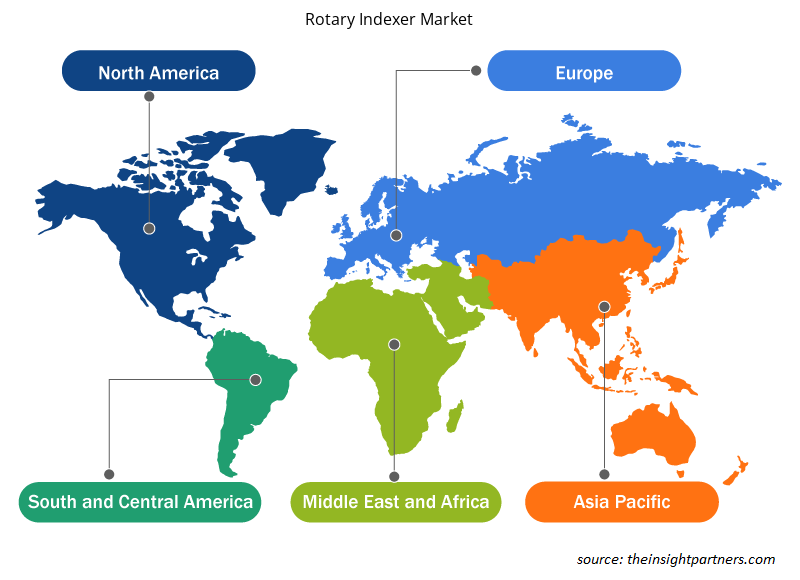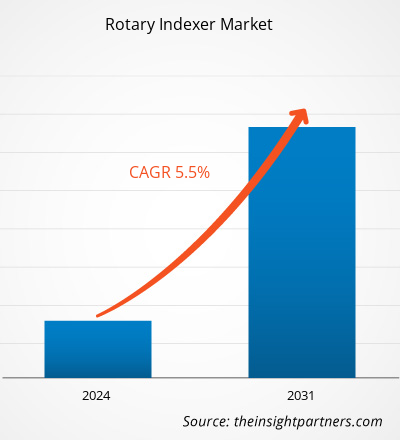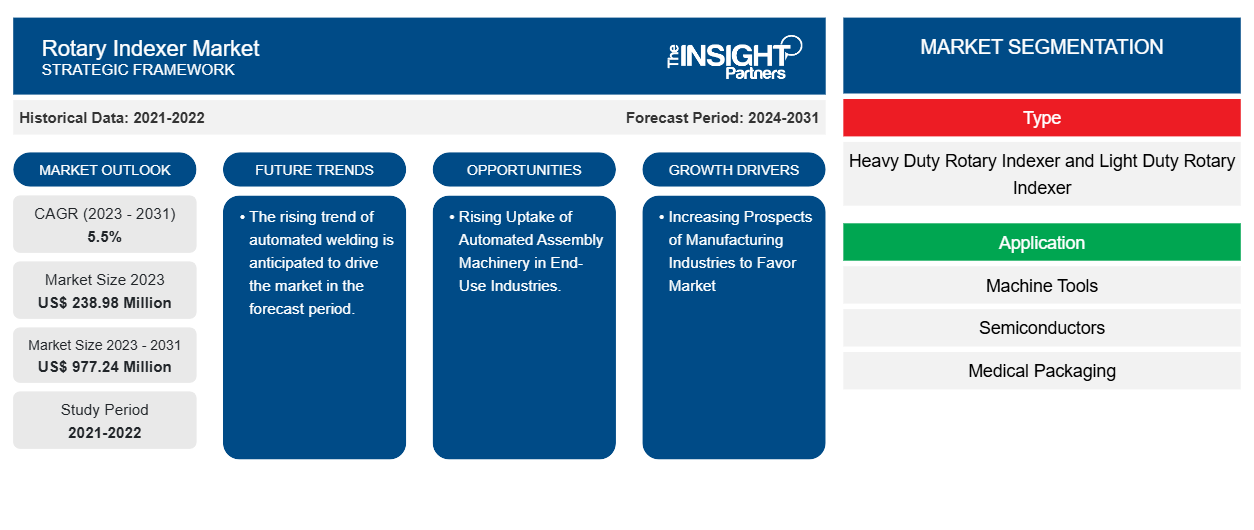Der Markt für Rotationsindexierer soll von 238,98 Millionen US-Dollar im Jahr 2023 auf 977,24 Millionen US-Dollar im Jahr 2031 anwachsen. Der Markt wird im Zeitraum 2023–2031 voraussichtlich eine durchschnittliche jährliche Wachstumsrate von 5,5 % verzeichnen. Die steigenden Aussichten in der Fertigungsindustrie und die Vorteile von Präzisionsrotationsindexierern gegenüber herkömmlichen Rotationsindexierern dürften die wichtigsten Treiber und Trends des Marktes sein.
Rotationsindexierer-Marktanalyse
Der Markt für Drehtischgetriebe verzeichnet weltweit ein deutliches Wachstum. Das Wachstum ist auf Faktoren wie die steigenden Aussichten in der Fertigungsindustrie und die Vorteile von Präzisionsdrehtischgetriebe gegenüber herkömmlichen Drehtischgetriebe zurückzuführen. Darüber hinaus wird erwartet, dass die zunehmende Verbreitung automatisierter Montagemaschinen in Endverbrauchsindustrien und der steigende Trend zum automatisierten Schweißen in den kommenden Jahren mehrere Chancen für den Markt bieten werden.
Marktübersicht für Rotationsindexierer
Das Rundschaltsystem ist ein hochentwickelter und hocheffizienter Mechanismus, der in verschiedenen Branchen zur Rationalisierung von Produktionsprozessen eingesetzt wird. Diese Automatisierungstechnologie ermöglicht die präzise Bewegung und Positionierung von Werkstücken in vorgegebenen Intervallen, sodass Montagearbeitsplätze bestimmte Aufgaben mit außergewöhnlicher Genauigkeit ausführen können.
Passen Sie diesen Bericht Ihren Anforderungen an
Sie erhalten kostenlose Anpassungen an jedem Bericht, einschließlich Teilen dieses Berichts oder einer Analyse auf Länderebene, eines Excel-Datenpakets sowie tolle Angebote und Rabatte für Start-ups und Universitäten.
-
Holen Sie sich die wichtigsten Markttrends aus diesem Bericht.Dieses KOSTENLOSE Beispiel umfasst eine Datenanalyse von Markttrends bis hin zu Schätzungen und Prognosen.
Treiber und Chancen auf dem Markt für Rotationsindexierer
Steigende Aussichten für die verarbeitende Industrie begünstigen den Markt
Der Fertigungssektor, beispielsweise durch maschinelles Lernen, Robotik und künstliche Intelligenz, konnten Maschinen in einer Reihe von Aktivitäten, darunter auch kognitive Aktivitäten, die auf verschiedenen Ebenen der Fertigung erforderlich sind, mit Menschen mithalten oder sie übertreffen. Die Produktivitätssteigerung liegt zwischen 10 % und 20 %, wenn an einer schlanken Montagelinie Automatisierung implementiert wird. Darüber hinaus ist Industrie 4.0 ein weiterer spannender Trend, der in den kommenden Jahren voraussichtlich den Fertigungssektor erobern wird. Die zunehmende Nutzung von Rundschalttischen hat zu einem zunehmenden Automatisierungsgrad im Fertigungssektor weltweit geführt.
Zunehmende Nutzung automatisierter Montagemaschinen in Endverbrauchsindustrien.
Ein automatisiertes Montagesystem wird mithilfe mechanisierter und automatisierter Geräte aufgebaut, die alle mehrere Prozesse bei der Herstellung eines einzelnen Artikels/Produkts ausführen. Mechanische Systeme sind normalerweise so konzipiert, dass sie feste, sich wiederholende Bewegungen ausführen, wie die festen Sequenzen, die zum Zusammenbauen von Teilen und Produkten erforderlich sind. Darüber hinaus gibt es auf dem Markt verschiedene Akteure, die automatisierte Montagemaschinen anbieten. Unternehmen wie Grob, HIRATA, ATS Automation Tooling Systems, NITTO SEIKO, Tach Precision Engineering, Teamtechnik (Dürr), Juki, Tateyama Auto Machine, Autec Mechanical und viele mehr.
Segmentierungsanalyse des Marktberichts für Rotationsindexierer
Wichtige Segmente, die zur Ableitung der Marktanalyse für Rotationsindexgeber beigetragen haben, sind Typ, Anwendung und Endverbrauchsbranche.
- Basierend auf dem Typ ist der Markt für Drehtischgetriebe in Schwerlast-Drehtischgetriebe und Leichtlast-Drehtischgetriebe unterteilt. Das Segment der Schwerlast-Drehtischgetriebe dürfte im Prognosezeitraum einen erheblichen Marktanteil halten.
- Basierend auf der Anwendung ist der Markt für Rotationsindexierer in Werkzeugmaschinen, Halbleiter, medizinische Verpackungen, automatisiertes Schweißen, Roboter und Montageschneidsysteme unterteilt. Es wird erwartet, dass das Segment Werkzeugmaschinen im Prognosezeitraum einen erheblichen Marktanteil halten wird.
- Nach Endverbrauchsbranche ist der Markt in die Branchen Automobil, Medizin und Gesundheitswesen, Elektronik, Transport und Luft- und Raumfahrt unterteilt. Es wird erwartet, dass die Automobilindustrie im Prognosezeitraum einen erheblichen Marktanteil halten wird.
Marktanteilsanalyse für Rotationsindexierer nach geografischer Lage
Der geografische Umfang des Marktberichts für Rotationsindexierer ist hauptsächlich in fünf Regionen unterteilt: Nordamerika, Asien-Pazifik, Europa, Naher Osten und Afrika sowie Süd- und Mittelamerika.
Nordamerika dominiert den Markt für Drehtischgeräte. Die hohen Technologieannahmetrends in verschiedenen Branchen in der nordamerikanischen Region haben das Wachstum des Marktes für Drehtischgeräte vorangetrieben. Faktoren wie die zunehmende Nutzung digitaler Tools und hohe Technologieausgaben von Regierungsbehörden, die steigenden Aussichten in der Fertigungsindustrie und die Vorteile von Präzisions-Drehtischgeräten gegenüber herkömmlichen Drehtischgeräten werden voraussichtlich das Wachstum des nordamerikanischen Drehtischgerätemarktes vorantreiben. Darüber hinaus zwingt eine starke Betonung von Forschung und Entwicklung in den entwickelten Volkswirtschaften der USA und Kanadas die nordamerikanischen Akteure dazu, technologisch fortschrittliche Lösungen auf den Markt zu bringen. Darüber hinaus gibt es in den USA viele Akteure auf dem Markt für Drehtischgeräte, die sich zunehmend auf die Entwicklung innovativer Lösungen konzentrieren. All diese Faktoren tragen zum Wachstum des Drehtischgerätemarktes in der Region bei.
Regionale Einblicke in den Markt für Rotationsindexierer
Die regionalen Trends und Faktoren, die den Markt für Rotationsindexgeber im Prognosezeitraum beeinflussen, wurden von den Analysten von Insight Partners ausführlich erläutert. In diesem Abschnitt werden auch die Marktsegmente und die Geografie von Rotationsindexgebern in Nordamerika, Europa, im asiatisch-pazifischen Raum, im Nahen Osten und Afrika sowie in Süd- und Mittelamerika erörtert.

- Erhalten Sie regionalspezifische Daten zum Rotationsindexer-Markt
Umfang des Marktberichts für Rotationsindexierer
| Berichtsattribut | Details |
|---|---|
| Marktgröße im Jahr 2023 | 238,98 Millionen US-Dollar |
| Marktgröße bis 2031 | 977,24 Millionen US-Dollar |
| Globale CAGR (2023 - 2031) | 5,5 % |
| Historische Daten | 2021-2022 |
| Prognosezeitraum | 2024–2031 |
| Abgedeckte Segmente |
Nach Typ
|
| Abgedeckte Regionen und Länder |
Nordamerika
|
| Marktführer und wichtige Unternehmensprofile |
|
Dichte der Marktteilnehmer für Rotationsindexierer: Die Auswirkungen auf die Geschäftsdynamik verstehen
Der Markt für Rotationsindexierer wächst rasant, angetrieben durch die steigende Nachfrage der Endnutzer aufgrund von Faktoren wie sich entwickelnden Verbraucherpräferenzen, technologischen Fortschritten und einem größeren Bewusstsein für die Vorteile des Produkts. Mit steigender Nachfrage erweitern Unternehmen ihr Angebot, entwickeln Innovationen, um die Bedürfnisse der Verbraucher zu erfüllen, und nutzen neue Trends, was das Marktwachstum weiter ankurbelt.
Die Marktteilnehmerdichte bezieht sich auf die Verteilung der Firmen oder Unternehmen, die in einem bestimmten Markt oder einer bestimmten Branche tätig sind. Sie gibt an, wie viele Wettbewerber (Marktteilnehmer) in einem bestimmten Marktraum im Verhältnis zu seiner Größe oder seinem gesamten Marktwert präsent sind.
Die wichtigsten auf dem Markt für Rotationsindexierer tätigen Unternehmen sind:
- Colombo Filippetti Sp. A
- Nabtesco Corporation
- FIBRO Indien
- Haas Automation, Inc
- TUNKERS Maschinenbau GmbH
- Goizper-Gruppe
Haftungsausschluss : Die oben aufgeführten Unternehmen sind nicht in einer bestimmten Reihenfolge aufgeführt.

- Überblick über die wichtigsten Akteure auf dem Markt für Rotationsindexierer
Neuigkeiten und aktuelle Entwicklungen zum Rotationsindex-Markt
Der Markt für Rotationsindexgeber wird durch die Erhebung qualitativer und quantitativer Daten nach Primär- und Sekundärforschung bewertet, die wichtige Unternehmensveröffentlichungen, Verbandsdaten und Datenbanken umfasst. Nachfolgend sind einige der Entwicklungen auf dem Markt für Rotationsindexgeber aufgeführt:
- DETRON hat gemeinsam mit PMC und KTR an der Entwicklung eines neuen Geräts mit dem Namen „Machine Tool Rotary Table Drive Efficiency Testing Device“ gearbeitet. Diese Technologie, die in Zusammenarbeit mit dem Precision Machinery Research and Development Center (PMC) und DETRON entwickelt wurde und die MONITEX-BT-Drehmomentsensortechnologie von KTR integriert, ist das erste Spezialgerät der Branche zur Messung der Effizienz von Drehtischantrieben. (Quelle: DETRON-Unternehmenswebsite, März 2024)
Marktbericht zu Rotationsindexierern – Umfang und Ergebnisse
Der Bericht „Marktgröße und Prognose für Rotationsindexierer (2021–2031)“ bietet eine detaillierte Analyse des Marktes, die die folgenden Bereiche abdeckt:
- Marktgröße und Prognose für Rotationsindexierer auf globaler, regionaler und Länderebene für alle abgedeckten wichtigen Marktsegmente.
- Markttrends für Rotationsindexierer sowie Marktdynamik wie treibende Faktoren, Einschränkungen und wichtige Chancen.
- Detaillierte PEST/Porters Five Forces- und SWOT-Analyse.
- Marktanalyse für Rotationsindexierer, die wichtige Markttrends, globale und regionale Rahmenbedingungen, wichtige Akteure, Vorschriften und aktuelle Marktentwicklungen abdeckt.
- Branchenlandschaft und Wettbewerbsanalyse, einschließlich Marktkonzentration, Heatmap-Analyse, prominenten Akteuren und aktuellen Entwicklungen auf dem Markt für Rotationsindexierer.
- Detaillierte Firmenprofile.
- Historische Analyse (2 Jahre), Basisjahr, Prognose (7 Jahre) mit CAGR
- PEST- und SWOT-Analyse
- Marktgröße Wert/Volumen – Global, Regional, Land
- Branchen- und Wettbewerbslandschaft
- Excel-Datensatz
Aktuelle Berichte
Erfahrungsberichte
Grund zum Kauf
- Fundierte Entscheidungsfindung
- Marktdynamik verstehen
- Wettbewerbsanalyse
- Kundeneinblicke
- Marktprognosen
- Risikominimierung
- Strategische Planung
- Investitionsbegründung
- Identifizierung neuer Märkte
- Verbesserung von Marketingstrategien
- Steigerung der Betriebseffizienz
- Anpassung an regulatorische Trends























 Kostenlose Probe anfordern für - Markt für Rotationsindexierer
Kostenlose Probe anfordern für - Markt für Rotationsindexierer